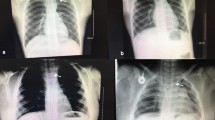Abstract
Mediport (also known as port, portacath or Infusaport) is a commonly placed central venous access in pediatric patients. Fibrin sheath formation around the central venous catheter is a common biological response leading to port malfunction in the form of inability to aspirate but preserved capacity for infusion of fluids. If fibrinolytic therapy fails, percutaneous fibrin sheath stripping via transfemoral route or replacement with a new mediport are routine/conventional treatments for a fibrin sheath. We describe a novel technique for removing a fibrin sheath by exteriorizing the catheter through the neck entry site, stripping the fibrin sheath from the catheter manually under sterile conditions and replacing the catheter via a peel-away sheath introduced through the same skin incision as an alternative to complete port replacement or attempted catheter stripping.




Similar content being viewed by others
References
Barnacle A, Arthurs OJ, Roebuck D, Hiorns MP (2008) Malfunctioning central venous catheters in children: a diagnostic approach. Pediatr Radiol 38:363–378
Crain MR, Mewissen MW, Ostrowski GJ et al (1996) Fibrin sleeve stripping for salvage of failing hemodialysis catheters: technique and initial results. Radiology 198:41–44
Funaki B (2002) Central venous access: a primer for the diagnostic radiologist. AJR Am J Roentgenol 179:309–318
Crain MR, Horton MG, Mewissen MW (1998) Fibrin sheaths complicating central venous catheters. AJR Am J Roentgenol 171:341–346
Tschirhart JM, Rao MK (1988) Mechanism and management of persistent withdrawal occlusion. Am Surg 54:326–328
Kidney DD, Nguyen DT, Deutsch LS (1998) Radiologic evaluation and management of malfunctioning long-term central vein catheters. AJR Am J Roentgenol 171:1251–1257
Crain M (1998) Management of fibrin sheaths I: percutaneous fibrin sheath stripping. Semin Dial 11:336–341
Gray RJ, Levitin A, Brown LC (2000) Percutaneous fibrin sheath stripping versus transcatheter urokinase infusion for malfunctioning well-positioned tunneled central venous dialysis catheters: a prospective, randomized trial. J Vasc Interv Radiol 11:1121–1129
Merport M, Murphy TP, Egglin TK, Dubel GJ (2000) Fibrin sheath stripping versus catheter exchange for the treatment of failed tunneled hemodialysis catheters: randomized clinical trial. J Vasc Interv Radiol 11:1115–1120
Author information
Authors and Affiliations
Corresponding author
Ethics declarations
Conflicts of interest
None
Rights and permissions
About this article
Cite this article
Medsinge, A.N., Escobar, F.A., Yilmaz, S. et al. A novel technique for removing a fibrin sheath from a mediport catheter in the pediatric population. Pediatr Radiol 49, 141–145 (2019). https://doi.org/10.1007/s00247-018-4243-4
Received:
Revised:
Accepted:
Published:
Issue Date:
DOI: https://doi.org/10.1007/s00247-018-4243-4




